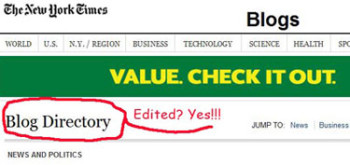
StinkyJournalism's study found that all of The New York Times' blogs are edited. (Image above is a screenshot detail from The New York Times web site. Our comments and highlighting in red, added.)
Clark Hoyt, the New York Times public editor, published a column on May 29 that addressed readers’ reactions to, and concerns about, a blog post that ran on the Times website this spring: In his blog post, Times reporter Corey Kilgannon described the apartment of recently deceased, famed jazz musician Hank Jones. The blog post accompanied a standard obituary published in the Times’ print edition.
Readers and Jones’s family members took to the comments section of the blog to immediately question the ethics of reporting on such a private scene. Hoyt noted that both the Times’ City Room editor Wendell Jamieson and the Times’ standards editor Philip Corbett said that “the same journalistic criteria” applied for both blogs and print stories.
However, Hoyt seemingly contradicted Times’ policy statements, ending his column “wondering whether a portrait of Jones in his later years would have been more deeply reported and carefully edited had it been conceived from the start as an article in the paper instead of a post on a blog.” In one of his last columns as public editor for The New York Times, Clark Hoyt wondered if the Times has “lesser standards for online journalism than for print journalism”. The trigger for his May 28 column was a blog post by Times reporter Corey Kilgannon for the Times’ City Room blog.
We assume that Hoyt was familiar with his own newspaper’s official procedure for editing blog posts, yet he still raised the question if the blog post “would have been more deeply reported and carefully edited had it been conceived from the start as an article in the paper instead of a post on a blog”. Hoyt created a paradox in his last weeks on his job because the Times company policy on Ethics in Journalism (see below) states clearly that blogs are treated the same as stories for the print edition.
“B5. 127. Personal journals [blogs] that appear on our official Web sites are subject to the newsroom’s standards of fairness, taste and legal propriety. Nothing may be published under the name of our company or any of our units unless it has gone through an editing or moderating process.”
Hoyt and his successor, Arthur Brisbane, did not get back to us, which made us curious. We wanted to find out how other newspapers manage their blogs. At first, we looked at major news corporations including Reuters and AOL, but we decided to focus our report on major U.S. newspapers with print newspaper editions.
STUDY HIGHLIGHTS :
|
Earlier, CJR asked if magazines edited their blogs
The Columbia Journalism Review‘s survey of 665 print magazines’ websites in March found that “copy editing (excluding blogs) is less rigorous online for more than half (59%) of magazines surveyed.”
The study focused on editing practices at websites affiliated with a print edition magazine.
CJR’s study further noted that 11% of the magazine websites surveyed don’t even copy edit online-only material. And, CJR found that 27% of the websites do fact check online-only material, “but less rigorously than print content.” Eight percent admitted to not fact checking online-only content and another eight percent fessed up to not fact checking any content – print or online.
With that context, the question raised by Hoyt at the Times and the CJR magazine study, iMediaEthics decided to take a closer look at major newspapers’ blogs.
In total, iMediaEthics looked at 591 blogs from the following news sites: The New York Times, The Wall Street Journal, The Washington Post, Los Angeles Times, USA Today, San Francisco Chronicle, New York Post, Chicago Tribune, Chicago Sun-Times, and the Boston Globe.
Most of the blogs were opinion blogs.
All newspapers except for The San Francisco Chronicle, The New York Post and the Chicago Sun Times said that all of their blogs were edited. The San Francisco Chronicle and the Chicago Sun-Times both told that blogs aren’t edited all of the time. The New York Post edits all of its blogs, with the exception of the blogs of six senior sports writers who occasionally live blog events.
Read the complete report on the ten newspapers’ blogs below:
Are Newspaper Blogs Edited?
With the rising popularity of social media, newspapers have also jumped on the bandwagon, setting up blogs, as well as Facebook and Twitter accounts. This move was not only necessary to keep up to date with technology, but also to compensate for the loss in sales of the print editions.
During the recent financial downturn, some U.S. newspapers, including the Seattle Post Intelligencer and the Christian Science Monitor, have stopped publishing print editions altogether, opting for online-only editions. All major U.S. newspapers have a representative Internet presence and publish much more content online than they could fit into their print editions. Along with this change, social media as an integrated tool plays a role in the news landscape now more than ever. However, these changes also raise questions about ethics, legal issues and journalistic standards.
Therefore, iMediaEthics thought it would be worthwhile to learn more about how newspapers manage blogs published on their websites. We looked at ten major U.S. newspapers and their 591 published blogs. We categorized the blogs based on their content and took notice of the blogs’ authors. Some of the results were unexpected, even surprising.
|
METHODOLOGY
We selected nine of the highest ranked news outlets based off Alexa’s newspaper rankings. We chose to include The Boston Globe because of its variety of blogs and excluded international sites. See the ten news outlets we studied with their corresponding ranking on Alexa on June 9.
For the purpose of this study, we define editing as someone besides the author reviewing the author’s work before and/or after publication. We verified information about each newspaper’s blogs both during and after the study in a combination of phone calls and e-mails.
|
What is a Blog & Who Blogs?
The Columbia Encyclopedia defines a blog as:
“An online, regularly updated journal or newsletter that is readily accessible to the general public by virtue of being posted on a website. Blogs typically report and comment on topics of interest to the author, and are usually written and posted using software specifically designed to facilitate blogging; they include hyperlinks to other website and, often, photos, video clips, and the like. The most recent entry by the blogger is posted at the beginning of the blog, with earlier entries following in reverse chronological order; comments and other responses to the blog by readers are often posted after each entry.” (July 19, 2010)
The word blog itself is the short form of web log, and originated in the 1990s from web (World Wide Web) and log (regular record of incidents).
According to USA Today, the Oxford English Dictionary added the word “blog” in 2003, which is quite late considering that the first blogs appeared in the early 1990s. The number of existing blogs in the U.S. varies from 2 million to more than 15 million.
The big gap between numbers can be explained from the various research methods used to collect the data. However, nobody knows exactly how many blogs exist or are still maintained.
The Pew Research Center undertook a survey about bloggers in July 2006 (Lenhart, A. & Fox, S.) and estimated that 147 million adult Americans use the Internet, 57 million read blogs (around 38% of Internet users) and 12 million keep a blog (8% of Internet users).
In March 2010, the Pew Research Center (Purcell, K., et. al.) presented an extended research report about “Understanding the Participatory News Consumer” and found out that “the typical online news participator is white, 36 years-old, politically moderate and Independent, employed full-time with a college degree and an annual income of $50,000 or more.“ The majority of news participators use social networking platforms (76%) and less than a third of news participators blog (26%).
On a typical day, the average participator searches for news on 3 to 5 different news websites, seeking 9 to 12 topics online, according to Pew’s study.
As of this date, no standard categories have been established to classify blogs in academia. Because academia hasn’t developed a framework for categorizing blogs, each research project has had to create its own categorization technique.
According to Mark Tremayne, an assistant professor at University of Texas, Austin’s journalism school, any generalization about “the blogsphere” is difficult “because of its size, diversity of content and variation in format.”
Overall, blogs can be categorized by genre and by purpose — whether the blog is for personal use or to advance corporate or organizational writings, for example.
iMediaEthics’ study: More on Methods
From June 9 to July 30, 2010, iMediaEthics looked at the blogs of the ten newspapers: The New York Times, The Wall Street Journal, The Washington Post, Los Angeles Times, USA Today, San Francisco Chronicle, New York Post, Chicago Tribune, Chicago Sun-Times and The Boston Globe.
We contacted editors, staffers and bloggers from each of the newspapers. During our research period, blogs have been eliminated or added, but all blogs which were published by the ten observed newspapers are included in the survey – even if the blog isn’t online anymore.
The blogs were counted and categorized into several groups according to their content and their appearance. Our grouping does not necessarily follow the classification on the websites of the newspapers, but rather a classification system for the purpose of this study. The goal is to provide a comprehensive classification system representative of the diverse nature of blogs. Our grouping among 591 blogs’ content is:
- Business [includes Economics, Finance and Real Estate]: (33)
- Culture [Theater and Literature]: (11)
- Ecology [Green Topics]: (8)
- Entertainment [Movies, TV and Music]: (59)
- Lifestyle [Magazine, Food, Fashion, Design, Travel, Photography, Health, Medicine, Animals, Automobiles, Religion & Spirit, etc.]: (78)
- Local [deals only with specific neighborhood issues, could be counted as hyper-local]: (41)
- News [breaking news according to daily news]: (8)
- Politics: (35)
- People [Parenting, Age, Job, Education, Self-Help, etc.]: (39)
- Sports: (119)
- Technology [Science]: (13)
- World [blogs dedicated to issues from outside the US]: (14)
- Opinion: (133)
The categorizing of a total of 591 blogs was not an easy task. Many blogs overlap in content. Therefore, the classification is based on an amalgam of: the content of the blogs, the newspapers’ description of the blogs and/or their authors. In cases where no blog description or author’s name was provided, we went through the first ten blog posts and classified them according to this sample.
The main topics of the observed blogs are opinion blogs (133), followed by sports (119), lifestyle (78), and entertainment (59).
Importantly, we checked to see if blogs were edited.
Overview of the Ten Observed Newspapers’ Websites
See below, figure 1 shows the number of blogs published by the ten observed newspapers’ websites. The sum for each newspaper includes all blogs published on their website, including non-staff blogs. The range of published blogs goes from 147 (San Francisco Chronicle) to 29 (USA Today). In total, iMediaEthics studied 591 blogs.
|
Figure 1: Number of newspaper blogs categorized by publisher |
We documented the responses from ten newspapers from the Alexa list of most trafficked U.S. newspapers, starting with learning how many of their published blogs are edited. Figure 2 gives an overview of the number of blogs which are edited compared to unedited blogs.
|
Figure 2: See above the number of edited vs. unedited newspaper blogs |
All but three of the ten studied newspapers stated that all their blogs are edited prior to or after publication. The San Francisco Chronicle, New York Post and Chicago Sun-Times were the exception. San Francisco Chronicle’s editor said that they don’t edit all blogs at all times, although the editor said they keep “an eye” on them.
Chicago Sun-Times likewise told us that “none of the blogs are edited all of the time.”
And, the New York Post told us it edits its blogs. However, six blogs by senior sports writers may include live blogging for select sports events, which are not edited.
|
Figure 3: Blogs of all ten studied newspapers are categorized above by content in percentages |
The above graph indicates that, surprisingly, only 1% of the studied blogs dealt with traditional news.
Study Results for Individual Newspapers‘s Blogs
1. The New York Times
During our research period, The New York Times’ website published 57 blogs.
The New York Times started publishing blogs in 2005 and some blog posts make it into the print edition.
According to our content grouping, most blogs focused on topics like lifestyle (11) or sports (11). Third most frequent are opinion-based blogs (8).
|
Figure 4: The New York Times’ blogs categorized by their content in percentages. The Times had blogs in all 13 of our categories. |
As previously mentioned, The New York Times is the only newspaper in our study which mentions in its ethical standards that online content must be treated the in the same way as print material. According to article B5/127 of The Times’ ethics in journalism policy, everything published by The Times is edited or goes through a moderation process. Bloggers are even asked to “write lively commentary on their preferences in […], but as journalists they must avoid taking stands on divisive public issues” (B5/130).
As said by Paul Boutin, a freelance blogger for The New York Times, Times’ editing involves an editor and a copy editor before a post is published online. iMediaEthics verified this information by e-mail from Philip B. Corbett, the associate managing editor for standards at The New York Times.
2. The Wall Street Journal
While we conducted our study, The Wall Street Journal published 37 blogs online. Most blogs, as expected, are in the business category (13) which is the biggest group followed by the world category (6).
|
Figure 5: The Wall Street Journal’s blogs categorized by their content in percentages. The Journal had blogs in 10 of 13 of our categories. |
Ashley Huston, communications director for Dow Jones, which owns The Wall Street Journal, told iMediaEthics that the published blogs by the Wall Street Journal are all edited. Huston said that the Wall Street Journal started publishing blogs in 2006.
3. The Washington Post
During the research period, 83 blogs were published online on The Washington Post’s website. In terms of content, most blogs are about sports (15) and opinion-based blogs (14).
|
Figure 6: The Washington Post’s blogs categorized by their content in percentages. The Post had blogs in all 13 of our categories. |
Kris Coretti, communications director at the Washington Post stated that their blogs are all edited.
4. Los Angeles Times
In our survey period, the Los Angeles Times had 47 blogs online. The categories with the most blogs is entertainment (10) and lifestyle (9) followed by sports (5) and people (5).
|
Figure 7: The Los Angeles Times’ blogs categorized by their content in percentages. The Times had blogs in all 13 of our categories. |
Tony Pierce, the Los Angeles Times blog editor, told iMediaEthics that all LA Times blogs are edited (including a copy editor). Most bloggers are staff members – probably about 75%, and the rest are freelance or contract bloggers.
Pierce explained that he’s more of a “blog purist,” and tries to keep the LA Times blogs as less about publishing the writers’ biography and more about the content. Pierces says blogs at the LA Times tend to be like an “ongoing conversation.”
5. USA Today
We looked at 29 blogs on the homepage of USA Today during our research period. In terms of content, most blogs were about sports (10). Lifestyle (6) and entertainment (5) came in second and third position.
|
Figure 8: USA Today’s blogs categorized by their content in percentages. USA Today had blogs in 8 of 13 of our categories. |
David Colton, the page one editor, explained via e-mail to iMediaEthics that blogs are “all about their bloggers”. According to Colton, most blogs cover the middle ground between a traditionally reported article and an opinion-based column.
“Every blog post gets read by the copy desk or an editor, but sometimes after it has been posted,” Colton explained. “We do this for speed-to-market, but also expect our bloggers to be precise, careful and always responsible.”
At USA TODAY, he added, the blogs, while more reader-friendly, are held to the same standards of accuracy and attribution as other USA TODAY content.
USA Today blogs also have an additional forum attached to the blog where the blogger can post questions and also can respond to answers.
6. San Francisco Chronicle
We reviewed 147 blogs during our research period which were published by the San Francisco Chronicle on their website, SFGate.com. Kevin Skaggs, the executive producer, informed iMediaEthics that SFGate.com has three different kinds of blogs: staff blogs, “city brights” blogs, and “community” blogs.
Skaggs told iMediaEthics via e-mail that staff and freelance blogs have companion editors who keep “an eye on the content, making any needed corrections promptly, etc., but in the majority of cases, the editors do not review the content before it’s published on the site (regardless of whether a blogger is live blogging or not). Some editors do review posts before they go live, but the majority do not.”
During our research period, 57 staff blogs, 84 “city brights” blogs, and 6 “community” blogs were published online.
The “city brights” blogs are written by “local notables,” Skaggs explained. “We train them on the blogging platform and distribute best practices and guidelines to them, but we do not necessarily train them how to write blogs,” Skaggs told iMediaEthics. All of the “city brights” blogs have a disclaimer that they are not edited. The “community” blogs are hyper-local blogs and are written by individuals from different neighborhoods. They are not edited by SFGate.com and therefore have a disclaimer too.
The 90 “city bright” and hyper-local blogs featured disclaimers that the work wasn’t edited. Concerning the content of the blogs, the majority of SFgate.com blogs were “city bright,” which are entirely opinion driven blogs (84). The staff blogs are mainly about sports (12), local issues (10), followed by lifestyle (9).
|
Figure 9: The San Francisco Chronicle’s blogs categorized by their content in percentages. The Chronicle had blogs in 12 of our 13 categories. |
7. New York Post
During our research period, we counted 40 blogs on the New York Post’s website. The majority of the blogs were about sports (24). After that, blogs on entertainment follow (7).
|
Figure 10: The New York Post’s blogs categorized by their content in percentages. The Post had blogs in all 7 of our 13 categories. |
The mobile project manager of the New York Post, Michael Vallane, told iMediaEthics that all blogs have editorial oversight (editing). The only exception is when senior sports staffers are blogging live about sports events, which applies to just 6 blogs.
8. Chicago Tribune
The Chicago Tribune hosted as many as 42 blogs during our research period. Most blogs were on sports (10), followed by lifestyle (9) and entertainment (6) by our content classification count.
|
Figure 11: The Chicago Tribune’s blogs categorized by their content in percentages. The Tribune had blogs in all 13 of our categories. |
Bill Adee, digital media editor, informed iMediaEthics via e-mail that all the Tribune blogs are edited, but “not necessarily” by a copy editor. He defines a blog as a piece of writing which has its main use to create a connection between the blogger and their readers.
9. Chicago Sun-Times
During our research period, the Chicago Sun-Times website contained 34 blogs. The majority of blogs (12) deal with sports, followed by blogs on lifestyle (7) and opinion-driven blogs (6).
|
Figure 12: The Chicago Sun-Times’ blogs categorized by their content in percentages. The Sun-Times had blogs in 7 of our 13 categories. |
Managing editor, Andrew Herrmann, told iMediaEthics via e-mail that “none of the blogs are edited all of the time. However, some stories that appear in print — reviews, interviews, etc. — are edited and end up being posted in blogs.”
10. The Boston Globe / Boston.com
We looked at 75 blogs. The Community Voices (14) blogs are written by “thought leaders from the area” and get selected by the paper according to David Beard, who was Boston.com’s editor at the time. (Beard left the newspaper earlier this month for the National Journal.) All of them are solely opinion-driven blogs, and all of them carry a disclaimer. The majority of the blogs are written about sports (19), followed by opinion blogs (15) and lifestyle blogs (11).
|
Figure 13: The Boston Globe’s blogs categorized by their content in percentages. The Globe had blogs in 10 of our 13 categories. |
Beard told us that all staff blogs are edited and have also a copy editor editing before posted online. Even though the Community Voices blogs are carry a disclaimer, they are also edited before published online. Boston.com news editor Jason Tuohey explained to iMediaEthics that the “Community Voices” blogs are copy edited for grammar and fact-checking, however the blogs serve as a space for local “thought leaders” to write — so the newspaper doesn’t influence what the bloggers write about.
Beard also told iMediaEthics that the term blog is associated with so many different versions, that he rather would use the term “microsite” which was introduced by WordPress.
* * * * * *
Claudia Haas is a graduate student in the master’s program for Communication and Cultural Management at Zeppelin University in Germany. Haas is from Austria and has a bachelor’s degree in international business administration from the University of Applied Sciences Eisenstadt. She has also interned for the Austrian Broadcasting Corporation in Vienna, Austria, and Moscow, Russia, and at the Moscow German Newspaper in Moscow.
Sydney Smith is a staff reporter for iMediaEthics. She has a bachelor’s degree in journalism and mass communications from the University of South Carolina and was a visiting politics and history student at University College Dublin, Ireland. She also writes for the Post and Courier’s entertainment section.







Comments Terms and Conditions